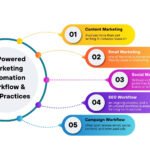In a world bursting with content, campaigns, and competition, the brands that win aren’t always the loudest—they’re the most strategic. Enter the 7 M’s of Marketing: a timeless, data-backed framework that helps you cut through the noise, build relevance, and drive measurable results. If you’ve ever found yourself throwing marketing tactics at the wall and hoping something sticks, this model is your roadmap to clarity. So, what are the 7 M’s of marketing? They’re the seven core elements—Market, Message, Mission, Message Design, Media Strategy, Money, and Measurement—that underpin every successful marketing strategy, from scrappy startups to global giants. In this expert guide, we’ll break each one down, share real-world stats, and show you how to apply them with purpose. Let’s unlock smarter marketing—one M at a time.
Also Read: What Are The 7 P’s in Marketing?
Why the 7 M’s Matter in 2025
In 2025, marketing is more than creative flair—it’s strategic architecture. The digital landscape has evolved into an always-on battlefield, where consumers demand relevance, consistency, and proof of value. Brands that succeed don’t rely on guesswork; they rely on structure. That’s where the 7 M’s of Marketing framework delivers.
Think of it as your strategic blueprint. Whether you’re launching a product, rebranding, or scaling a campaign, this model ensures that every element of your marketing—from messaging to measurement—is aligned, intentional, and optimized for results. According to a 2024 report by HubSpot, businesses that follow structured marketing frameworks are 42% more likely to exceed their lead generation goals. Another study from McKinsey shows that companies that integrate analytics and clear messaging see up to 60% more engagement across digital channels.
So, when someone asks what are the 7 M’s of marketing, it’s not just an academic question—it’s a performance playbook. From refining your target audience to executing with precision across media channels, this framework helps modern marketers hit the sweet spot between creativity and conversion.
The 7 M’s of Marketing: Full Breakdown
If you’re building a strategy that converts, retains, and scales, you need more than scattered tactics—you need the 7 M’s of Marketing. Each “M” is a mission-critical pillar, and when combined, they form a holistic, high-performing marketing ecosystem. Below is a breakdown of each one—with insights, examples, and real-world relevance baked in.
1. Market: Who Are You Really Talking To?
At the core of every winning campaign is a deep understanding of your market—not just demographics, but motivations. You need to know who you’re targeting, what they care about, and why they buy. In 2025, generic marketing doesn’t work.
A Salesforce study found that 76% of consumers expect brands to understand their needs. That starts with data-driven audience segmentation, psychographic profiling, and behavior mapping. Use customer personas to laser-focus your messaging and personalize the experience.
2. Message: What Are You Saying—And Why Should They Care?
Your message isn’t just words—it’s the value you bring to the table. This is where your brand promise, value proposition, and emotional hooks come alive. Effective messaging creates connection. It turns a scroll into a stop, a click into a conversion.
Tip: Brands that connect emotionally outperform competitors by 85% in sales growth (Harvard Business Review). So tell a story. Solve a problem. Make them feel something.
3. Mission: Why Does Your Brand Exist?
Behind every great brand is a mission that matters. This isn’t fluff—it’s your North Star. A clear mission defines your values, fuels your messaging, and builds long-term loyalty.
Brands with a strong sense of purpose grow twice as fast as those without, according to Deloitte. Your mission should inform not just what you do, but how and why you do it. When your mission aligns with customer values, you build a tribe—not just a customer base.
4. Message Design: How Are You Presenting Your Brand?
It’s not just what you say—it’s how you say it. Message design is about your brand’s tone, visual style, and creative execution. From Instagram captions to email headers, everything needs to look and feel you.
Consistent branding across all channels increases revenue by 23% (Lucidpress). Invest in cohesive visuals, voice, and content structure to create a brand that’s instantly recognizable.
5. Media Strategy: Where Is Your Audience Listening?
Even the sharpest message falls flat in the wrong channel. Your media strategy determines where your marketing lives—and whether it reaches the right eyes. Should you double down on Instagram Reels or focus on SEO content? The answer lies in your audience’s behavior.
According to Statista, 91% of marketers now use social media for brand awareness, but only 57% pair it with strong conversion strategies. Choose your platforms wisely and distribute content with purpose.
6. Money: What’s the Budget—and Is It Working for You?
Money isn’t just about how much you spend—it’s about how strategically you spend it. Your marketing budget should be allocated based on goals, channel performance, and ROI projections.
According to Gartner, CMOs allocated 9.5% of total company revenue to marketing in 2024. But high-performing teams don’t just budget—they measure and pivot based on outcomes. Track ROI relentlessly and invest in what moves the needle.
7. Measurement: Are You Winning—or Just Busy?
You can’t optimize what you don’t measure. Measurement is the backbone of every modern marketing plan. Track key performance indicators (KPIs), run A/B tests, and analyze what’s working. Then tweak. Then test again.
Brands that prioritize data-driven marketing are 3X more likely to improve customer acquisition, according to McKinsey. Set clear benchmarks, review them monthly, and make decisions based on performance, not gut feelings.
What are the 7 M’s of marketing? They’re the building blocks of a marketing system that thinks, performs, and adapts—and they’ll take your strategy from scattered to smart.
Quick-Glance Table: The 7 M’s Cheat Sheet
Sometimes you just need a clear, at-a-glance view—and that’s exactly what this cheat sheet delivers. Whether you’re in a strategy meeting, drafting a pitch deck, or refining a campaign, this table gives you the distilled essence of each “M” in the 7 M’s of marketing framework. It’s designed for fast recall and smart application.
| M | Core Focus | Description | Target |
| Market | Target Audience | Define your ideal customers using segmentation, demographics, and behaviors. | target audience, market segmentation, buyer persona |
| Message | Brand Story & Promise | Craft an emotionally resonant, consistent brand message and value proposition. | brand messaging, value proposition, emotional connection |
| Mission | Purpose & Positioning | Align your marketing with your “why”—clarity of brand values and identity. | brand mission, brand purpose, brand positioning |
| Message Design | Creative & Brand Identity | Design visuals and messaging to reflect tone, style, and voice across assets. | brand voice, creative strategy, content creation |
| Media Strategy | Channel & Content Distribution | Choose platforms based on audience behavior and performance. | media channels, digital marketing, content distribution |
| Money | Budget Allocation & ROI | Spend smart—allocate resources based on goals and return potential. | marketing budget, ROI, marketing spend |
| Measurement | Analytics & Continuous Optimization | Track performance using KPIs and adapt campaigns to maximize impact. | marketing analytics, KPIs, performance metrics, data-driven |
This isn’t just a list—it’s your marketing decision matrix. Each M supports the others, and when they’re all working in sync, you’ve got a lean, mean, results-generating machine.
Putting It All Together: How to Apply the 7 M’s of Marketing
So now you know the what—but how do you actually use the 7 M’s to drive better campaigns, build stronger brands, and get better ROI?
Here’s the secret: don’t treat these M’s like isolated checkboxes. Think of them as interconnected gears in a well-oiled marketing machine. When one turns, it powers the others. When one’s off, your entire strategy can drag.
Start here:
Step 1: Audit Your Current Strategy
Use each M as a lens.
- Market: Are your customer personas detailed and current?
- Message: Is your value proposition clear and differentiated?
- Mission: Do your campaigns reflect your core brand purpose?
- Message Design: Is your content visually cohesive and on-brand?
- Media Strategy: Are you on the platforms where your audience actually hangs out?
- Money: Is your budget tied to results—not just activity?
- Measurement: Do you have real-time analytics dashboards tracking performance?
Even the savviest marketing teams fall short in one or more of these areas. That’s why regularly revisiting each “M” keeps your strategy future-proof and focused.
Step 2: Prioritize Based on Weak Spots
You don’t need to fix everything at once. Focus where the payoff is biggest. For example:
- If you’ve nailed your messaging but haven’t analyzed your media channels in months, it’s time to shift your attention there.
- If your campaigns aren’t converting, maybe your audience targeting (Market) or creative design (Message Design) needs a refresh.
Step 3: Make the 7 M’s Part of Your Workflow
Build the 7 M’s into your planning documents, campaign reviews, and brainstorming sessions. Treat them like your marketing commandments.
Every major move—new product, content strategy, or ad campaign—should be reviewed through this framework.
Insider Tip:
High-performing marketing teams revisit the 7 M’s quarterly. They don’t just ask, “What are the 7 M’s of marketing?”—they ask, “How well are we executing each one, right now?”
Real-World Examples of the 7 M’s in Action
Let’s go beyond theory. To truly understand what are the 7 M’s of marketing, you need to see how real brands apply them to drive results—because the magic happens in the execution. Below are quick-hit case studies that show the power of this framework in motion.
E-Commerce Brand: “Market + Message = Conversion Lift”
A mid-sized beauty retailer noticed stagnant sales despite aggressive ad spend. The problem? They were targeting everyone—and resonating with no one.
By tightening their Market focus to Gen Z and millennial shoppers with specific skin concerns, and refining their Message to highlight clean ingredients and visible results, their click-through rate jumped by 38%, and average order value increased by 22% within three months.
Key takeaway: A sharper understanding of your target audience + a relevant message = more qualified traffic and stronger conversions.
SaaS Startup: “Money + Measurement = Smarter Scaling”
A SaaS company offering workflow automation tools hit a plateau with their paid ads. Instead of increasing spend, they revisited their Money strategy—focusing on cost-per-lead and lifetime value metrics. They paired this with more robust Measurement using Mixpanel and HubSpot dashboards.
By reallocating 30% of their ad budget toward high-performing keywords and optimizing landing pages, they reduced customer acquisition cost by 27%, while growing MRR by 15%.
Key takeaway: You don’t always need more budget—you need smarter allocation and performance-driven decision-making.
Sustainable Fashion Brand: “Mission + Message Design = Brand Love”
A DTC fashion brand built around eco-conscious apparel leaned into their Mission—sustainability and transparency. But it wasn’t showing up consistently in their Message Design.
After revamping their website, updating packaging, and aligning their tone of voice across social platforms, they saw a 42% increase in brand engagement and landed features in major publications like Vogue and Fast Company.
Key takeaway: Your mission only matters if it’s visible, shareable, and woven into your brand identity.
Mobile App: “Media Strategy + Message Design = Viral Growth”
A meditation app saw slow uptake despite strong user reviews. Their marketing was scattered—some influencer collabs here, a few ads there.
They refined their Media Strategy, focusing on TikTok and Instagram Reels where their target audience spent time. They also upgraded their Message Design, using emotionally resonant UGC, calming visuals, and bold copy. The result? A 340% spike in downloads in 60 days.
Key takeaway: Right message + right channel + right format = massive momentum.
These aren’t just stories—they’re proof that when the 7 M’s work together, they work.
Conclusion: Why the 7 M’s Are Still the Smartest Marketing Framework
If you’ve been wondering what are the 7 M’s of marketing, here’s your answer in full clarity: they’re not just concepts—they’re the foundation of modern marketing that actually performs. From refining your target audience to crafting a killer message, choosing the right channels, and tracking every click and conversion, the 7 M’s turn reactive marketing into intentional, results-driven execution.
The beauty of this framework is its flexibility. Whether you’re launching your first product or scaling a global campaign, the 7 M’s provide structure without stifling creativity. They force you to ask the hard questions:
- Are we solving the right problem for the right person?
- Are we spending time and money where it counts?
- Are we clear on what success looks like—and are we measuring it?
The most successful marketers today aren’t the ones who simply hustle harder—they’re the ones who build smarter. And the smartest place to start? Right here—with a framework that ensures every move you make has purpose, alignment, and ROI behind it.
Bottom line: Now that you understand what are the 7 M’s of marketing, you’ve got the clarity, confidence, and tools to build a strategy that scales. Use it. Test it. Own it.
Frequently Asked Questions on What Are The 7 M’s of Marketing
Let’s seal the deal with a laser-focused questions that targets real search intent and reinforces answers to questions asked by users like you.
What are the 7 M’s of marketing in simple terms?
The 7 M’s of marketing refer to a framework that includes: Market, Message, Mission, Message Design, Media Strategy, Money, and Measurement. These elements work together to help marketers build targeted, strategic, and results-driven campaigns.
Why are the 7 M’s of marketing important in 2025?
In today’s data-saturated and attention-fragmented landscape, using the 7 M’s of marketing helps brands stay focused. It ensures your message reaches the right audience, through the right channels, with a clear return on investment.
How can I use the 7 M’s of marketing in my business?
Start by auditing your current strategy. Define your ideal customer (Market), craft a compelling story (Message), align your efforts with your brand purpose (Mission), and measure everything for impact. Apply all seven pillars consistently for best results.
What’s the difference between the 7 M’s of marketing and the 7 P’s?
While both are strategic frameworks, the 7 M’s focus more on the internal strategy and execution—audience, communication, budget, and performance—whereas the 7 P’s (Product, Price, Place, etc.) focus on the broader marketing mix. Think of the 7 M’s as the engine room powering the bigger ship.
Are the 7 M’s of marketing still relevant today?
Absolutely. The core principles behind the 7 M’s—customer focus, brand clarity, and data-backed decisions—are more relevant than ever in 2025. Smart marketers use this framework to navigate complexity and cut through the noise.













